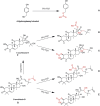Sulfur fumigation of botanical drugs: impact on chemical composition and pharmacological properties, and advances in detection technologies
- PMID: 40756979
- PMCID: PMC12313704
- DOI: 10.3389/fphar.2025.1635850
Sulfur fumigation of botanical drugs: impact on chemical composition and pharmacological properties, and advances in detection technologies
Abstract
Traditional Chinese medicine (TCM), a fundamental aspect of traditional medicine, is highly regarded for its natural efficacy and diverse applications. However, sulfur fumigation, a prevalent processing technique used to prevent insect and mold infestations, poses significant risks, including the presence of Sulfur Dioxide (SO2) residues, alterations in chemical compositions, diminished therapeutic effects, and heightened toxicity. As the demand for TCM continues to rise, ensuring its quality and safety becomes increasingly critical. This review explores the significance of analytical and regulatory methods for monitoring SO2 residues and the chemical changes induced by sulfur fumigation. The application of sulfur fumigation significantly impacts the chemical and pharmacological properties of TCM, leading to notable changes in its bioactive components. Studies show that the structure and concentration of the main components, such as ginsenosides, anthraquinones, and flavonoids are changed by this process, which decreases their pharmacological activity, which includes antibacterial, anti-inflammatory, and antioxidant properties. Additionally, the sulfur dioxide and heavy metals generated during sulfur fumigation have posed new toxicological concerns. Prolonged exposure to these residues may result in respiratory problems and potential carcinogenic effects. In recent years, researchers have created various innovative detection technologies, including fluorescent probe rapid detection methods and machine learning algorithms, to improve the precision of identifying and quantifying chemical changes in sulfur-fumigated samples. Promoting safe alternative drying methods, including natural and hot-air drying, along with desulfurization techniques, can significantly reduce the damage caused by sulfur fumigation to the chemical composition of botanical drugs. This manuscript advocates for sustainable practices to ensure the safe use of botanical drugs, protect public health, and promote responsible processing, storage, and utilization of botanical drug products. Although existing research has revealed the impact of sulfur fumigation on the chemical and pharmacological properties of certain TCM, most studies suffer from issues such as small sample sizes and lax experimental condition control, which limit the generalizability of their conclusions. Moreover, the absence of systematic research on key factors like sulfur fumigation duration and temperature makes it challenging to establish a precise quantitative relationship between the extent of sulfur fumigation and the resulting quality changes in medicinal materials.
Keywords: SO2 redisues; chemical metabolites; detection technologies; pharmacological impacts; sulfur fumigation.
Copyright © 2025 Xu, Jin, Wang, Wei and Liu.
Conflict of interest statement
The authors declare that the research was conducted in the absence of any commercial or financial relationships that could be construed as a potential conflict of interest.
Figures




Similar articles
-
Management of urinary stones by experts in stone disease (ESD 2025).Arch Ital Urol Androl. 2025 Jun 30;97(2):14085. doi: 10.4081/aiua.2025.14085. Epub 2025 Jun 30. Arch Ital Urol Androl. 2025. PMID: 40583613 Review.
-
Short-Term Memory Impairment.2024 Jun 8. In: StatPearls [Internet]. Treasure Island (FL): StatPearls Publishing; 2025 Jan–. 2024 Jun 8. In: StatPearls [Internet]. Treasure Island (FL): StatPearls Publishing; 2025 Jan–. PMID: 31424720 Free Books & Documents.
-
The Black Book of Psychotropic Dosing and Monitoring.Psychopharmacol Bull. 2024 Jul 8;54(3):8-59. Psychopharmacol Bull. 2024. PMID: 38993656 Free PMC article. Review.
-
Systemic Inflammatory Response Syndrome.2025 Jun 20. In: StatPearls [Internet]. Treasure Island (FL): StatPearls Publishing; 2025 Jan–. 2025 Jun 20. In: StatPearls [Internet]. Treasure Island (FL): StatPearls Publishing; 2025 Jan–. PMID: 31613449 Free Books & Documents.
-
Sexual Harassment and Prevention Training.2024 Mar 29. In: StatPearls [Internet]. Treasure Island (FL): StatPearls Publishing; 2025 Jan–. 2024 Mar 29. In: StatPearls [Internet]. Treasure Island (FL): StatPearls Publishing; 2025 Jan–. PMID: 36508513 Free Books & Documents.
References
-
- Bashir S., Hussain S. Z., Jan N., Naseer B., Zargar I. A., Murtaza I., et al. (2025). Structural integrity, bioactive components, and physico-chemical characteristics of Kashmiri saffron (crocus sativus L.) as affected by different drying techniques. Food Chem. 476, 143511. 10.1016/j.foodchem.2025.143511 - DOI - PubMed
-
- Cai H., Cao G., Li L., Liu X., Ma X.-Q., Tu S.-C., et al. (2013). Profiling and characterization of volatile components from non-fumigated and sulfur-fumigated flos Lonicerae japonicae using comprehensive two-dimensional gas chromatography time-of-flight mass spectrometry coupled with chemical group separation. Molecules 18, 1368–1382. 10.3390/molecules18021368 - DOI - PMC - PubMed
Publication types
LinkOut - more resources
Full Text Sources
Research Materials
Miscellaneous

